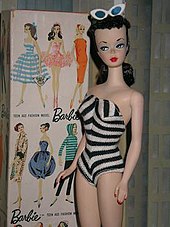Your Cart is Empty
EVERY ITEM MARKED DOWN 50% STORE WIDE CLEARANCE

Barbie is a fashion doll created by American businesswoman Ruth Handler, manufactured by American toy and entertainment company Mattel , and introduced on March 9, 1959. The toy is the figurehead of an eponymous brand that includes a range of fashion dolls and accessories. Barbie has been an important part of the toy fashion doll market for over six decades. Mattel has sold over a billion Barbie dolls, making it the company's largest and most profitable line.[1] The brand has expanded into a multimedia franchise since 1984, including video games, computer-animated films, television/web series, and a live-action film.
Barbie and her male counterpart, Ken, have been described as the two most popular dolls in the world.[2] Mattel generates a large portion of Barbie revenue though related merchandise — accessories, clothes, friends, and relatives of Barbie. Writing for Journal of Popular Culture in 1977, Don Richard Cox noted that Barbie has a significant impact on social values by conveying characteristics of female independence, and with her multitude of accessories, an idealized upscale lifestyle that can be shared with affluent friends.[3]
During a trip to Europe in 1956 with her children Barbara and Kenneth, Ruth Handler came across a German toy doll called Bild Lilli.[5][6] The adult-figured doll was exactly what Handler had in mind, so she purchased three of them. She gave one to her daughter and took the others back to Mattel. The Lilli doll was based on a popular character appearing in a satirical comic strip drawn by Reinhard Beuthin for the newspaper Bild.[7] The Lilli doll was first sold in Germany in 1955, and although it was initially sold to adults, it became popular with children who enjoyed dressing her up in outfits that were available separately.[7][8]

Upon her return to the United States, Handler redesigned the doll (with help from local inventor-designer Jack Ryan) and the doll was given a new name, Barbie, after Handler's daughter Barbara. The doll made its debut at the American International Toy Fair in New York City on March 9, 1959.[9] This date is also used as Barbie's official birthday.
The first Barbie doll wore a black-and-white zebra striped swimsuit and signature topknot ponytail, and was available as either a blonde or brunette. The doll was marketed as a "Teen-age Fashion Model", with her clothes created by Mattel fashion designer Charlotte Johnson.[10]
Analysts expected the doll to perform poorly due to her adult appearance and widespread assumptions about consumer preferences at the time. Ruth Handler believed it was important for Barbie to have an adult appearance, but early market research showed that some parents were unhappy about the doll's chest, which had distinct breasts.[11]
Barbie sold about 350,000 units in her first year, beating market expectations and generating upside risk for investors. Sales of Barbie exceeded Mattel's ability to produce her for the first three years of her run. The market stabilized for the next decade while volume and margin increased by exporting refurbished dolls to Japan. Barbie was manufactured in Japan during this time, with her clothes hand-stitched by Japanese homeworkers.[12]
Louis Marx and Company sued Mattel in March 1961. After licensing Lilli, they claimed that Mattel had "infringed on Greiner & Hausser's patent for Bild-Lilli's hip joint", and also claimed that Barbie was "a direct take-off and copy" of Bild-Lilli. The company additionally claimed that Mattel "falsely and misleadingly represented itself as having originated the design". Mattel counter-claimed and the case was settled out of court in 1963. In 1964, Mattel bought Greiner & Hausser's copyright and patent rights for the Bild-Lilli doll for $21,600.[13][14]
Barbie's appearance has been changed many times, most notably in 1971 when the doll's eyes were adjusted to look forward rather than having the demure sideways glance of the original model. This would be the last adjustment Ruth would make to her creation as, three years later, she and her husband Elliot were removed from their posts at Mattel after an investigation found them guilty of issuing false and misleading financial reports.[11]
This information came from Wikipedia
Comments will be approved before showing up.